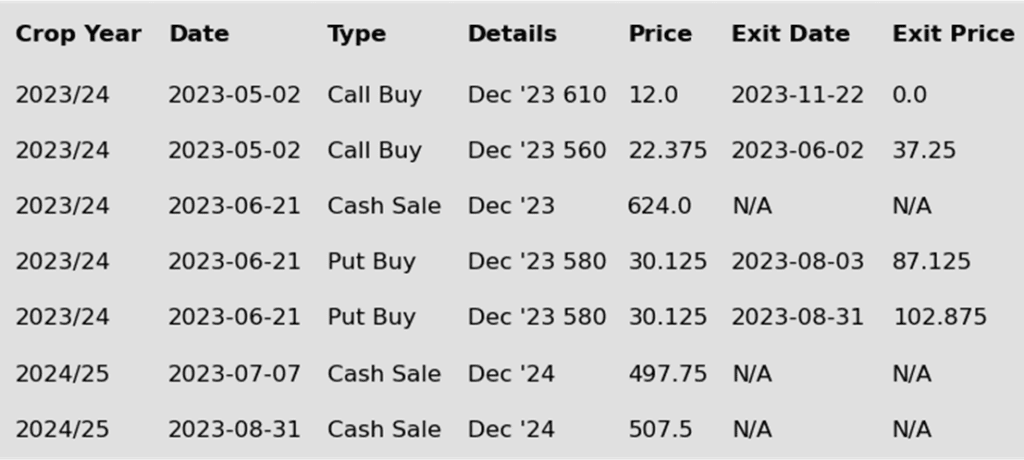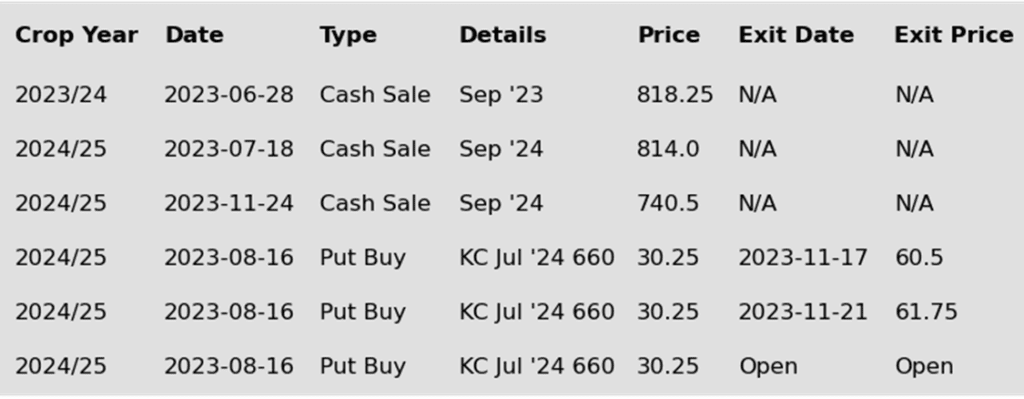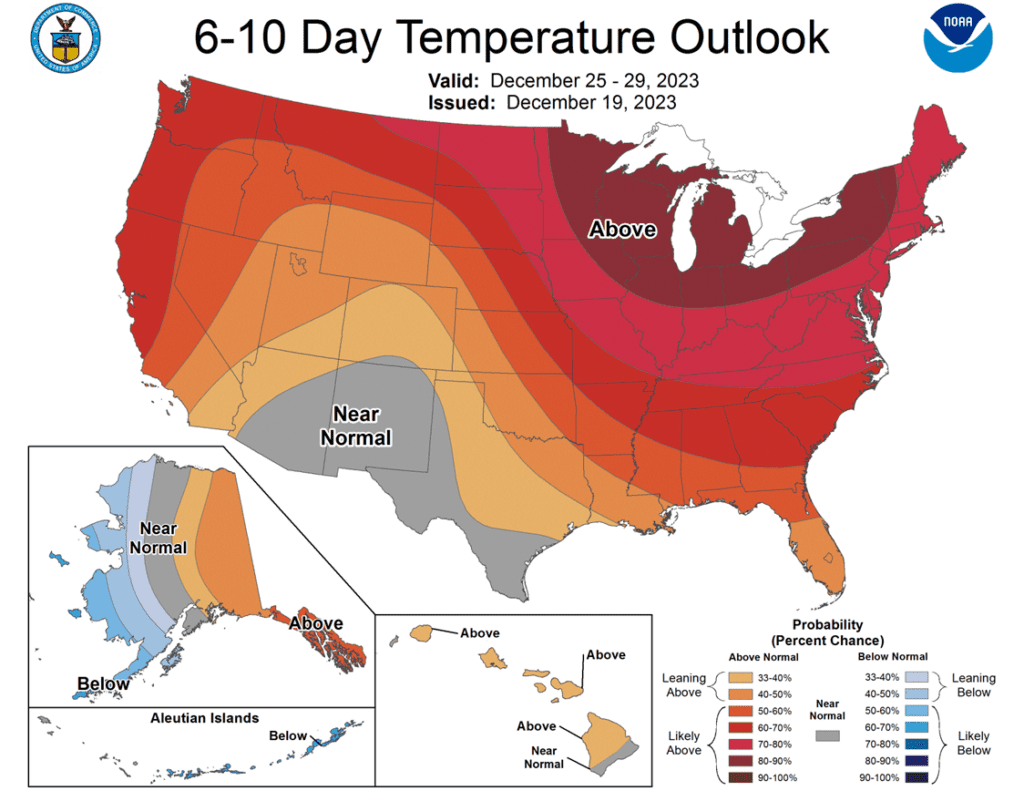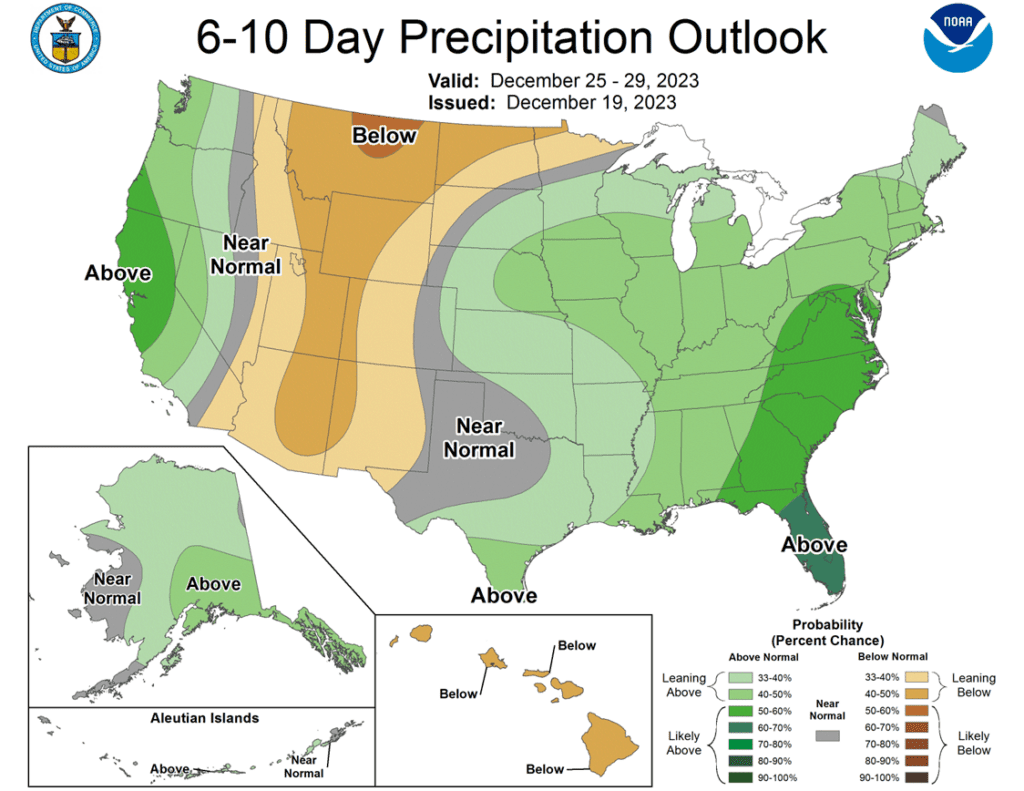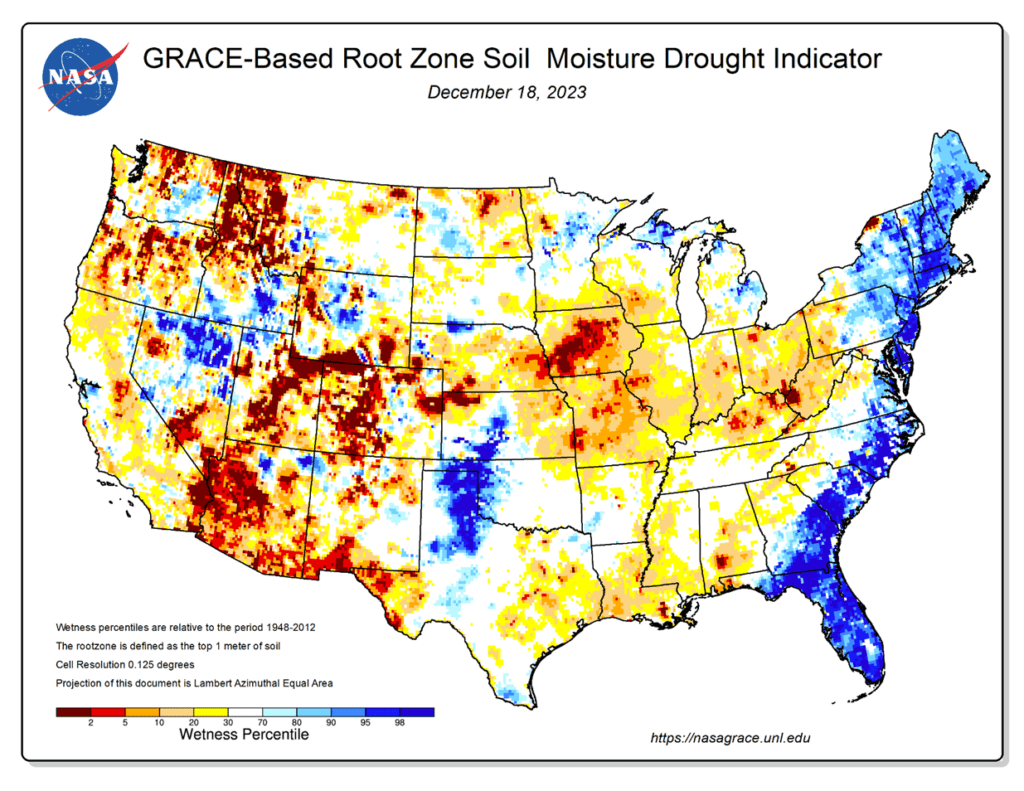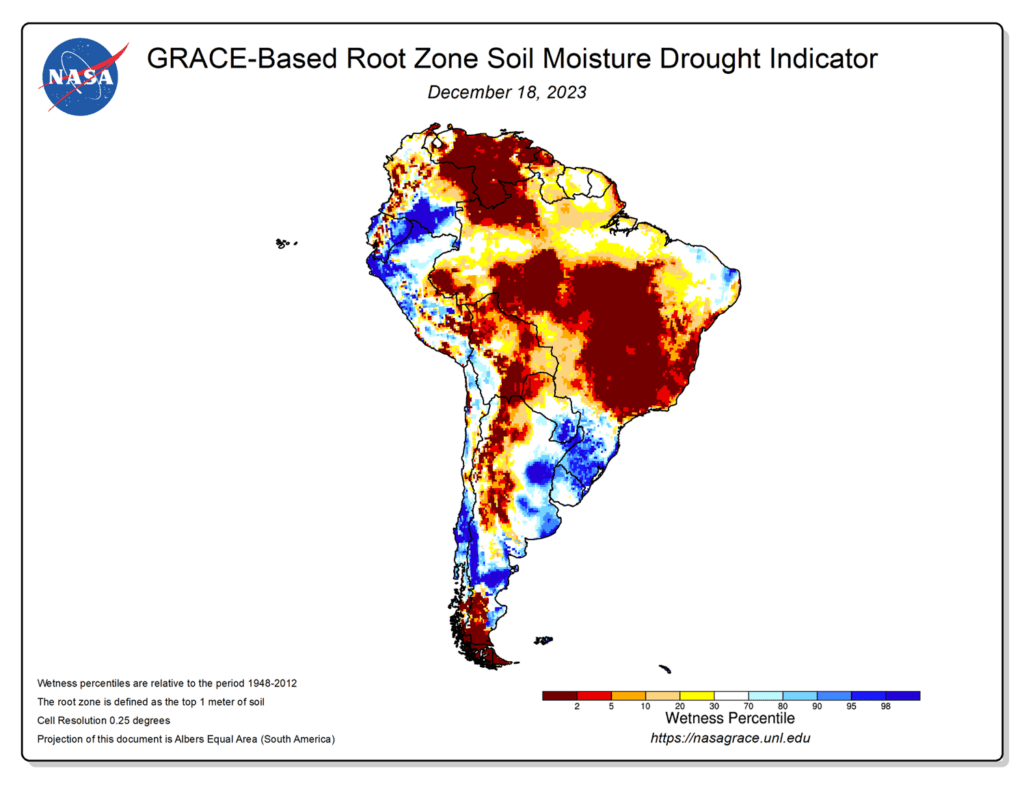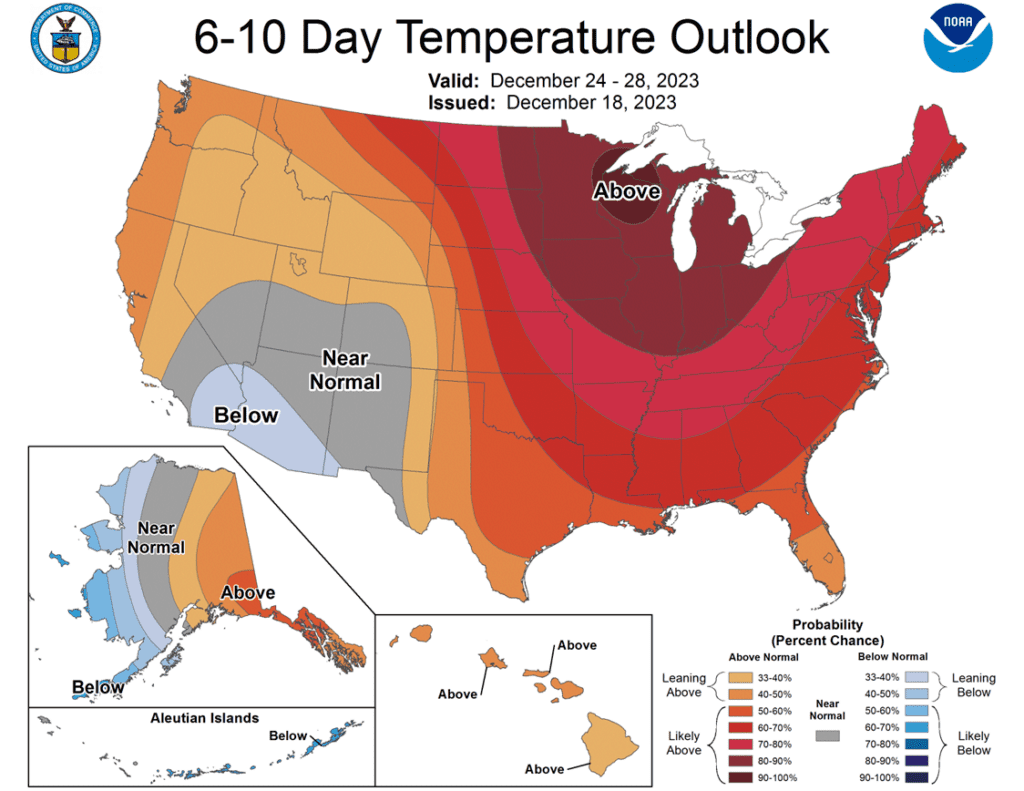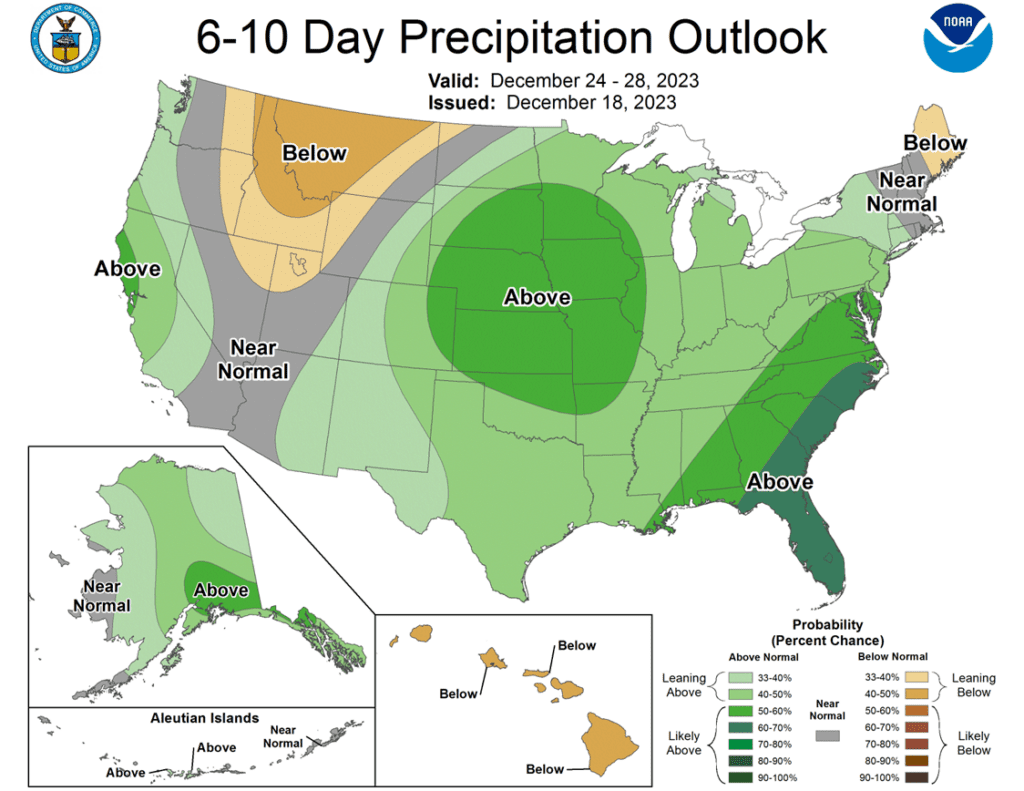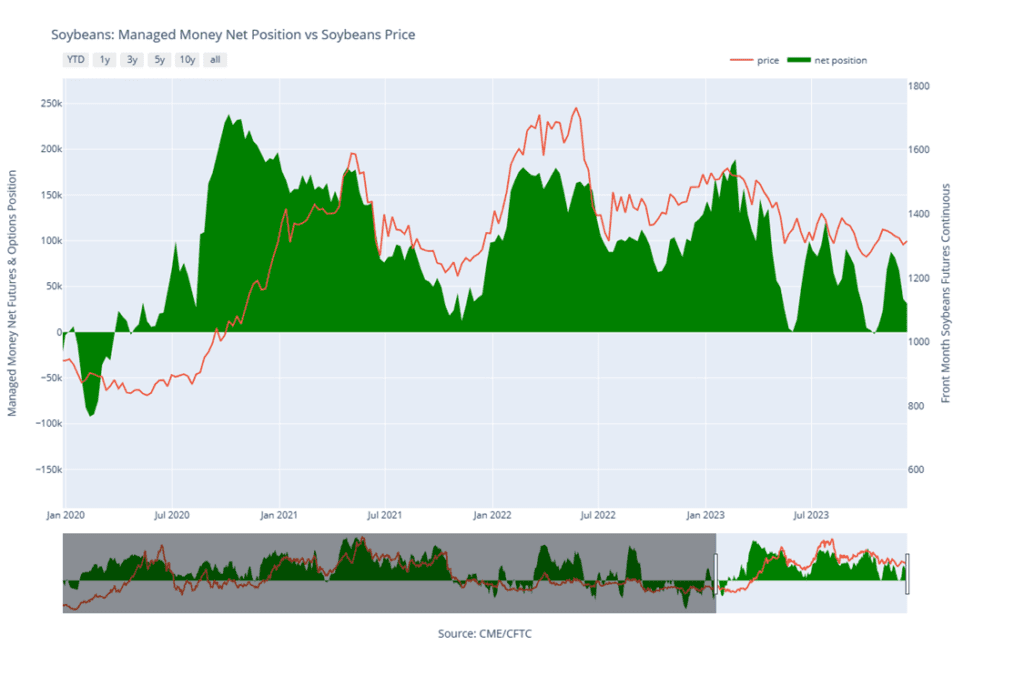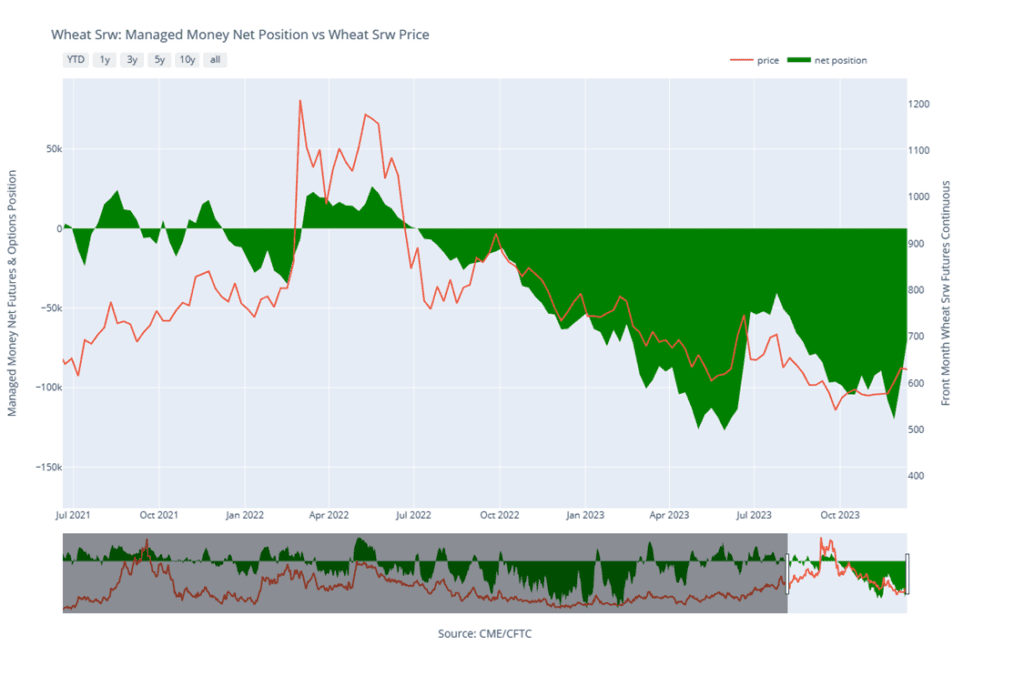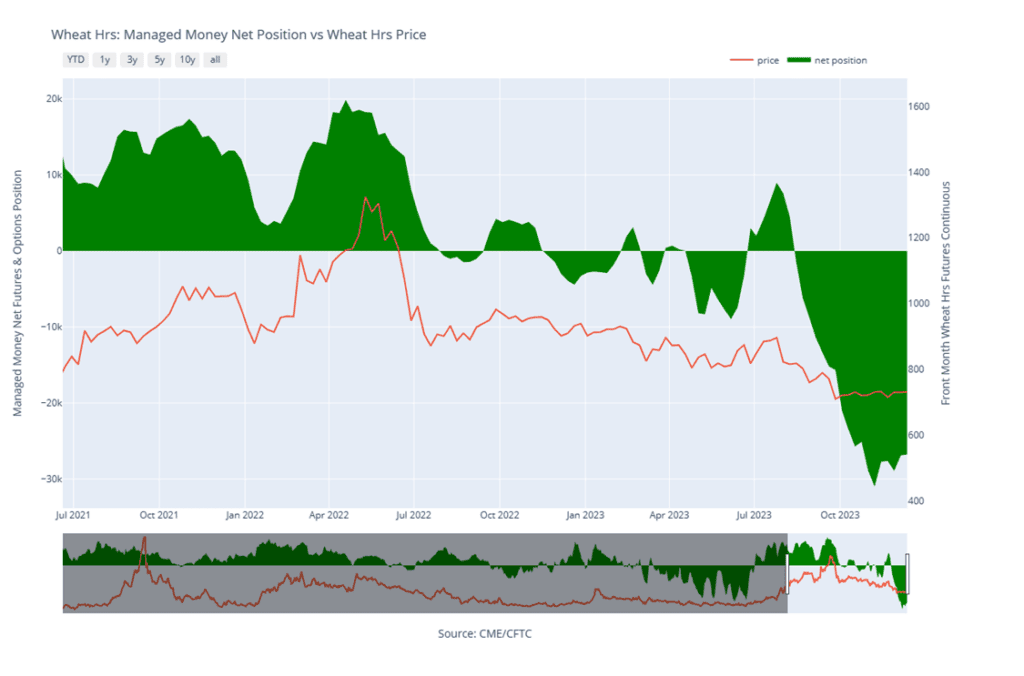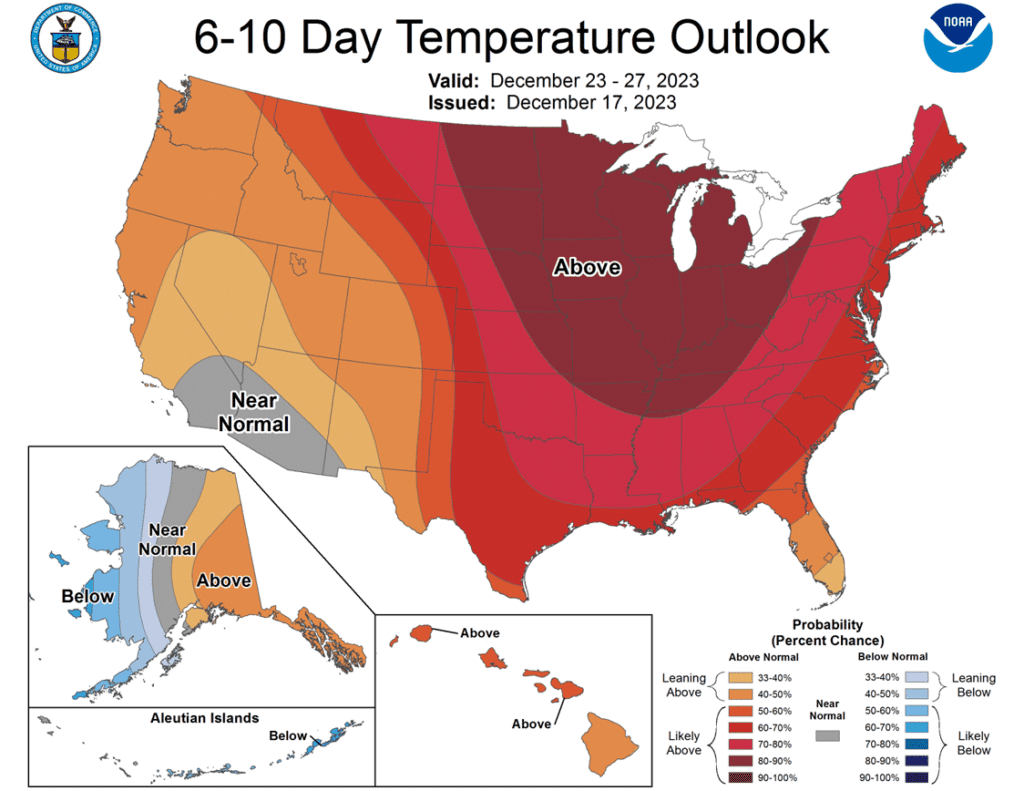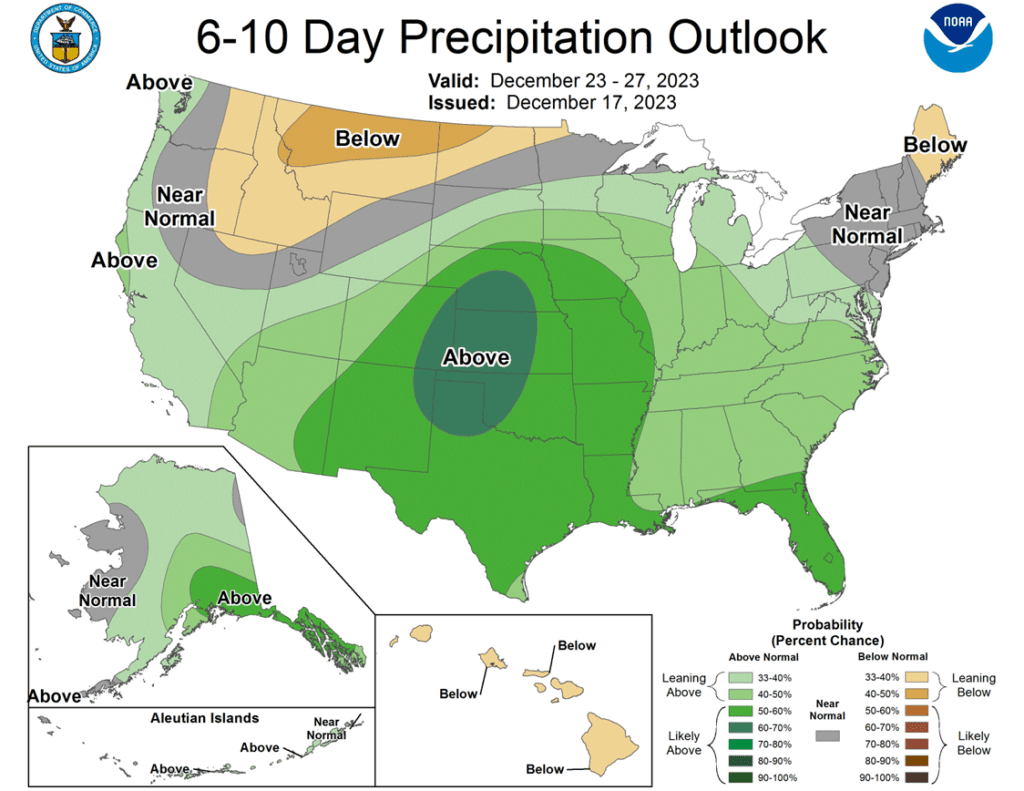12-21 End of Day: Markets Close Mixed on Expectations of Favorable Weather
The CME and Total Farm Marketing offices will be closed
Monday, December 25, in observance of Christmas
All prices as of 2:00 pm Central Time
Grain Market Highlights
- Solid export sales and consolidation ahead of the upcoming extended weekend supported the corn market, which shook off most of yesterday’s losses in a tight 4 ¾ cent range.
- The soybean market traded mostly lower throughout the day, with two sided trade with pressure coming from improved rain expectations for Brazil, and weaker soybean meal and oil.
- Soybean oil and meal both closed lower on the day, with soybean oil sharply lower, down 1.43 cents, as it continues to trade sideways, and meal at a fresh 2-month low. Today’s losses in the products contributed to the slide in the soybean market as January and March Board crush margins gave up another 15 ¾ and 6 ¾ cents respectively.
- Two sided trade dominated the wheat complex, which settled mixed on the day, with Chicago the strongest, Minneapolis the weakest, and nearby KC firmer versus the deferred. Disappointing export sales and expectations of favorable weather for the southern Plains added pressure, while a lower US dollar lent support.
- To see the updated US Drought Monitor, 5-day precipitation forecast, and Brazil’s 2-week precipitation forecast, courtesy of the NDMC, National Weather Service, and NOAA, scroll down to other Charts/Weather Section.
Note – For the best viewing experience, some Grain Market Insider content is best viewed with your phone held horizontally.
Corn
Corn Action Plan Summary
- No new action is recommended for 2023 corn. Since the beginning of August, the corn market has traded sideways largely between 470 and 500. October’s brief breakout to 509 ½ and the subsequent failure to stay above the 50-day moving average indicates there is significant resistance in that price range. The failure of December’s USDA report to provide a bullish influence on the market puts the market at risk of drifting sideways to lower without a bullish catalyst. During last summer’s June rally, Grain Market Insider recommended making sales when Dec ’23 was around 624. For now, Grain Market Insider will continue to hold tight on any further sales recommendations for the next few weeks with the objective of seeking out better pricing opportunities. If the market has not turned around by then, Grain Market Insider may sit tight on the next sales recommendations until spring.
- No new action is recommended for 2024 corn. Since late February ’22, Dec ’24 has been bound by 485 ¾ on the bottom and 602 on the top. After testing 491 to 547 last July, it has mostly traded between 500 and 525. During this time, Dec ’24 has held up better as bear spreading has allowed Dec ’24 to maintain more of its value versus old crop prices as traders attempt to price in a larger 2023 carryout with more uncertainty remaining for the 2024 crop. Moving forward, the risk for 2024 prices is the same as for 2023 prices, which is a continuation of a sideways to lower trend without a bullish catalyst. Grain Market Insider is watching for signs of a change in the current trend to look at recommending buying Dec ’24 call options. This past spring, Grain Market Insider recommended buying Dec ‘23 560 and 610 call options ahead of the summer rally and having those in place helped provide confidence to pull the trigger on recommending 2023 sales into that sharp rally, knowing that if corn kept rallying and went to 700 or 800 that the call options would protect those sold bushels.
- No Action is currently recommended for 2025 corn. Grain Market Insider isn’t considering any recommendations at this time for the 2025 crop that will be planted two springs from now. It will probably be late winter or early spring of 2024 before Grain Market Insider starts considering the first sales targets.
To date, Grain Market Insider has issued the following corn recommendations:
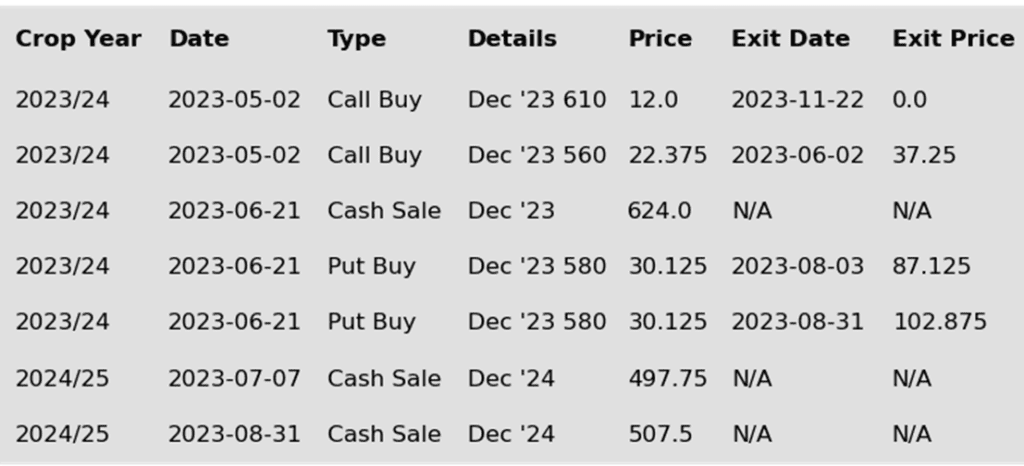
- The corn market held above the new recent low of 468 ¼ and reversed yesterday’s losses in two sided trade as it begins to consolidate ahead of the extended Christmas weekend.
- This morning, the USDA released weekly export sales as of December 14, and corn sales came in as expected, totaling 1.013 mmt (39.9 mb). Corn sales commitments now total 1.109 bb for 23/24 and are up 37% from a year ago. The current pace is ahead of USDA projections, but the market still needs to see consistent export sales totals.
- The closure of two major rail crossings into Mexico, caused by the migrant crises at the southern border, is limiting corn shipments into Mexico. It is currently estimated that about 1 mb of grain is being held up each day and that Mexico has about a 2 – 3 week supply. The closures may be adding resistance to prices with Mexico being the largest importer of US corn, and that they may need to look for other sources if the issue isn’t resolved soon.
- The recent price drop in corn has given the US an edge in the world export market, with US prices currently cheaper than Argentina and Brazil out of the market for now.
- The latest release of the US Drought Monitor shows that 46% of the US corn area is currently in drought areas, an increase of 2% from last week. Though with the forecast calling for good rains through the Midwest over the weekend, conditions are likely to improve.
- South American weather forecasts are staying supportive for the crop going into the end of the year with improved precipitation. The improved weather forecast is limiting buying strength in the corn and soybean markets.

Above: After posting bearish reversals on December 6 and 8, the market slowly eroded and traded through 470 support. Without fresh bullish input, the market runs the risk testing major support near 460. If a bullish catalyst does enter the market, overhead resistance comes in between 490 and 497, and again near 510.

Soybeans
Soybeans Action Plan Summary
- No new action is recommended for 2023 soybeans. Front month soybeans continue to be rangebound, largely between 1290 and 1400. At some point, the front month will eventually break out of that range, and if it breaks out to the downside, then the first risk would be 1180. If the breakout occurs to the topside, then the first opportunity would be 1510. The biggest looming catalyst behind a potential downside breakout is the projected record global carryout of soybeans, while the biggest looming catalyst for a potential upside breakout is continued adverse South American weather. Given the uncertainty of which direction the market will go, Grain Market Insider recently recommended adding to sales as the current price level is still historically good. It’s been disappointing how the market has been unable to push higher despite the South American planting disruptions. Because of that, Grain Market Insider’s concern is that, if the weather pattern doesn’t remain adverse, the path of least resistance could be lower. Grain Market Insider will continue to look at additional sales opportunities, as well as potential re-ownership strategies.
- No action is recommended for the 2024 crop. Since the inception of the Nov ’24 contract, it has traded at a discount to the 2023 crop from as much as 142 back in July, to as little as 17 ¾ in early October during harvest. While the spread difference between the two crops has seen a good amount of volatility, Nov ’24 has been largely rangebound between 1250 and 1320 since it rallied off its 1116 ¼ low last May. To date, Grain Market Insider has not recommended any sales for next year’s soybean crop. First sales targets will probably be early winter at the earliest. Currently, Grain Market Insider’s focus is also on watching for any opportunities to recommend buying call options.
- No Action is currently recommended for 2025 Soybeans. Grain Market Insider isn’t considering any recommendations at this time for the 2025 crop that will be planted two springs from now, and it may be some time before conditions are conducive to consider making any recommendations. Be patient as we monitor the markets for signs of improvement.
To date, Grain Market Insider has issued the following soybean recommendations:

- Soybeans ended the day lower for the fourth consecutive day, as improved Brazilian weather forecasts heavily impact the soy complex. Both soybean meal and oil were lower today, but bean oil posted the largest losses due to lower palm and crude oil.
- Global shipping problems have contributed to the pressure on soybeans, along with the rest of the grain complex, as the lack of movement and rising costs affect margins. Two main railways leading into Mexico are currently closed at Eagle Pass and El Paso, many shipping routes in the Red Sea are suspended due to rebel attacks, and shipping through the Panama Canal is also restricted due to low water levels.
- In Argentina, violent protests have broken out as citizens voice their frustration with the new government policies, especially those related to increased export taxes. Producers were anticipating friendly export policy from the new president, but instead were met with increased taxes on their grains.
- Today’s export sales report showed 73 mb of soybeans exported last week for 23/24 and 5 mb for 24/25, which was in line with analyst expectations. China and unknown destinations accounted for 54 mb of those exports. Sales for soybean meal were 148k tons and below analyst expectations.

Above: After posting a high of 1398 ½ in November, soybeans found support around 1292. Overhead, nearby resistance remains near 1350 and again around 1400. If the market breaks support at 1292, it runs the risk of testing 1250.

Wheat
Market Notes: Wheat
- Wheat had a mixed close, with Chicago contracts staying just above water, but a lower close in Kansas City and Minneapolis futures. Some support is stemming from a lower US Dollar Index today, which is forming a bearish pennant chart pattern. The formation of this pattern would signal more downside for the dollar, which, in theory, should make US exports more attractive and boost global business.
- On a bearish note, Russia continues to be the world’s wheat export leader, with FOB values cheaper than other origins, around $260 to $265 per mt. They recently fulfilled tenders by Egypt and Saudi Arabia and are likely to continue to get much of the world export business.
- Weekly US wheat export sales at 11.9 mb for 23/24 were a bit disappointing, and shipments last week at 12.4 mb are behind the weekly pace of 16.7 mb needed to reach the USDA’s export goal of 725 mb. Currently, wheat commitments are down 3% from last year at 546 mb.
- Over the holiday weekend, the US Plains should see mostly warmer temperatures. Additionally, the southern Plains have more chances for rain over the next seven days or so. This rain may add pressure to the market, with soil moisture conditions looking a lot more optimal than last year.
- SovEcon has increased their estimate of the Russian 2024 wheat harvest to 91.3 mmt, which is up 1.5 mmt from the previous projection. Favorable weather was cited as the reason for the increase, with conditions looking promising in winter wheat regions.
- According to Argus Media, the French soft wheat area for the 2024 harvest will hit the lowest level since the year 2000 at 4.238 million hectares. This comes after several weeks of heavy rain and is said to be based on feedback from over 1,200 farmers. Many areas of France are said to have received nearly 14 inches of rain from mid-October to mid-December, with higher totals in some regions.
Chicago Wheat Action Plan Summary
- No new action is currently recommended for 2023 Chicago wheat. Between late July and the end of November, front month Chicago wheat trended lower, driven mostly by weak US demand and lower world wheat prices. During that time, and as managed funds established most of their short position of nearly 120,000 contracts, the market became extremely oversold. Since then, as the market rallied to a high of 649 ½, China made several US SRW wheat purchases, and funds covered more than 23,000 short contracts. During that runup, Grain Market Insider recommended making an additional sale to take advantage of the elevated prices in case the rally was temporary since US wheat prices remain elevated relative to other world exporters, despite the increase in demand. If the market remains strong and continues to rally, Grain Market Insider will consider potential re-ownership strategies to protect current sales and add confidence to make additional sales at higher prices.
- No new action is recommended for 2024 Chicago wheat. From the end of July, the July ’24 contract has slowly stepped its way down to a low of 586 in sympathy with the front month contract where managed money established a large short position during that time. Since then, July ’24 rallied alongside the March ’24 contract, as the funds covered over 30k contracts of their nearly 130k short contract position. While bearish headwinds remain, the funds continue to carry a large short position and seasonals remain supportive for the addition of weather risk premium, which are two factors that could fuel further short covering and another leg up in prices. At the end of August, Grain Market Insider recommended purchasing July 590 puts to prepare for further price erosion. Back in June, Grain Market Insider recommended two separate sales that averaged about 720 to take advantage of the brief upswing. If the market receives the needed stimulus to move prices back toward this summer’s highs, Grain Market Insider is prepared to recommend adding to current sales levels and possibly even purchasing call options to protect those sales. Otherwise, the current recommended put position will add a layer of protection if prices erode further, and Grain Market Insider will be prepared to recommend covering some of those puts to offset much of the original cost and move toward a net neutral cost for the remaining position.
- No action is currently recommended for 2025 Chicago Wheat. Grain Market Insider isn’t considering any recommendations at this time for the 2025 crop that will be planted next fall. It will probably be mid-winter before Grain Market Insider starts considering the first sales targets.
To date, Grain Market Insider has issued the following Chicago wheat recommendations:
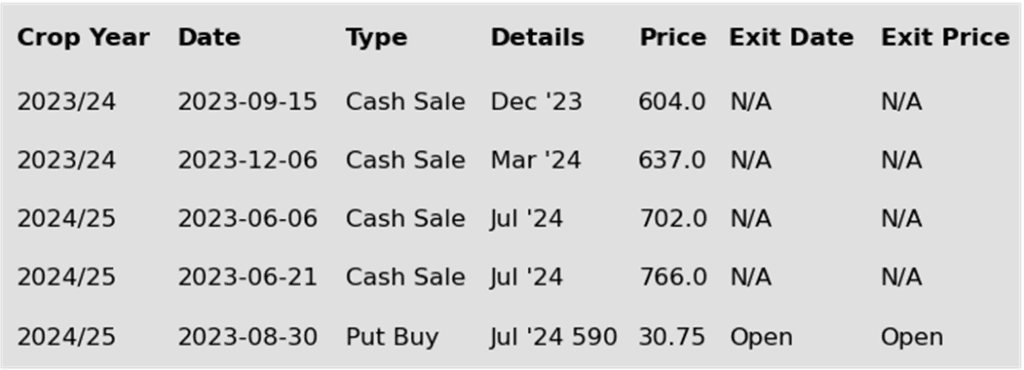

Above: After rallying to 649 ½, Chicago wheat became overbought and turned lower after the December 8 USDA report. Since then, the market has found nearby support near 600. Nearby resistance remains overhead near 650, with additional resistance between 660 and 665. If the market breaks nearby support, it may test the 50-day moving average, and then support near 556.
KC Wheat Action Plan Summary
- No new action is recommended for 2023 KC wheat crop. Since late July old crop KC wheat has been in a downtrend that has largely been driven by managed fund selling on low world wheat prices and weak US export demand. As the selloff progressed, the market became oversold, and the funds established the largest short position in three years. Even though bullish headwinds remain, these two factors have fueled the recent short-covering rally, which could extend much further if a bullish catalyst enters the market. This would also line up with the historical tendency for price appreciation as the market builds risk premium going into wintertime. Grain Market Insider’s strategy is to look for price appreciation going into this winter, as weather becomes a more prominent market mover and may consider suggesting additional sales if prices become over extended.
- No new action is recommended for 2024 KC wheat. At the end of August, the July ’24 contract broke out of roughly a one-year trading range and stepped down to a 609 ¼ low in late November, largely driven by managed fund selling in the front month on weak US export demand and lower world wheat prices. Since then, the funds covered part of their large short position which also rallied prices in the July ’24 contract. While bearish headwinds remain, managed funds continue to hold a sizable, short position, and price seasonals remain positive for adding weather risk premium. These are two factors that could fuel additional short covering and rally prices in the months ahead. Back in August, Grain Market Insider recommended buying Jul’24 KC wheat 660 puts to protect the downside following the range breakout. As the market recently got further extended into oversold territory and the July contract showed signs of support near 630, Grain Market Insider recommended exiting 75% of the originally recommended position. Moving forward, Grain Market Insider is prepared to recommend exiting the last 25% on any further supportive market developments.
- No action is currently recommended for 2025 KC Wheat. Grain Market Insider isn’t considering any recommendations at this time for the 2025 crop that will be planted next fall. It will probably be mid-winter before Insider starts considering the first sales targets.
To date, Grain Market Insider has issued the following KC recommendations:


Above: Since posting bearish reversals on December 6 and 8, the market has been consolidating while holding support around 625, with close in resistance just overhead at the 50-day moving average. If the market breaks lower, the next area of support may come in around 595 and 575. Resistance above the 50-day moving average remains around 675 – 680.
Mpls Wheat Action Plan Summary
- No new action is currently recommended for the 2023 New Crop. Following last July’s rally, the market has slowly stair-stepped lower, primarily due to low world wheat prices, weak US export demand, and managed fund selling. With the funds building a record large short position as the market sold off. Since weak US export demand remains the main impediment to higher prices, the market continues to be at risk of further downside erosion. The record large fund short position could fuel a rally back higher if a bullish catalyst enters the scene, and if that happens, it may signal that a near-term low is in place. Earlier this year, Grain Market Insider made a sales recommendation during the July rally near 820, and with that sale in place, Grain Market Insider’s strategy is to look for price appreciation this winter with an eye on considering additional sales around 725 – 775, and again north of 800. If at that point the market remains strong and continues to rally, Grain Market Insider will consider potential re-ownership strategies to protect current sales and add confidence to make additional sales at higher prices.
- No new action is recommended for 2024 Minneapolis wheat. At the end of August, the Sept ’24 contract traded to a peak of 871 ¾ and has continued to slowly stair-step lower, largely driven by lower world wheat prices, weak US export demand, and managed fund selling, and as the selloff progressed, the funds built up a record large short position. While bearish headwinds remain, the significant oversold condition of the market and the large fund net short position are two factors that could fuel a short-covering rally in the months ahead. Price seasonals are also supportive as prices tend to build in some risk premium going into the winter months. Back in August, Grain Market Insider recommended buying July ’24 KC wheat 660 puts to protect the downside following a 1-year range breakout in KC wheat. Though recently, as the KC market extended further into oversold territory and the July ‘24 KC wheat contract showed signs of support near 630, Grain Market Insider recommended exiting 75% of the originally recommended position. While in the same time frame, Grain Market Insider also recommended making an additional sale as the Sept ’24 Minneapolis contract broke long time 743 support. For now, moving forward, Grain Market Insider is prepared to recommend exiting the last 25% of the open puts on any further supportive market developments.
- No action is currently recommended for the 2025 Minneapolis wheat crop. Grain Market Insider isn’t considering any recommendations at this time for the 2025 crop that will be planted two springs from now. It will probably be mid-winter before Grain Market Insider starts considering the first sales targets.
To date, Grain Market Insider has issued the following Minneapolis wheat recommendations:


Above: After making a new contract low on November 27, the March contract found buying interest from its oversold status and record fund short. Since then, the market posted a bearish reversal on December 6, showing significant resistance in the 750 area. If prices can break through upside resistance, they could run toward 790. If prices retreat, nearby support could be found around 718, with further support near the recent low of 697 ½.

Other Charts / Weather
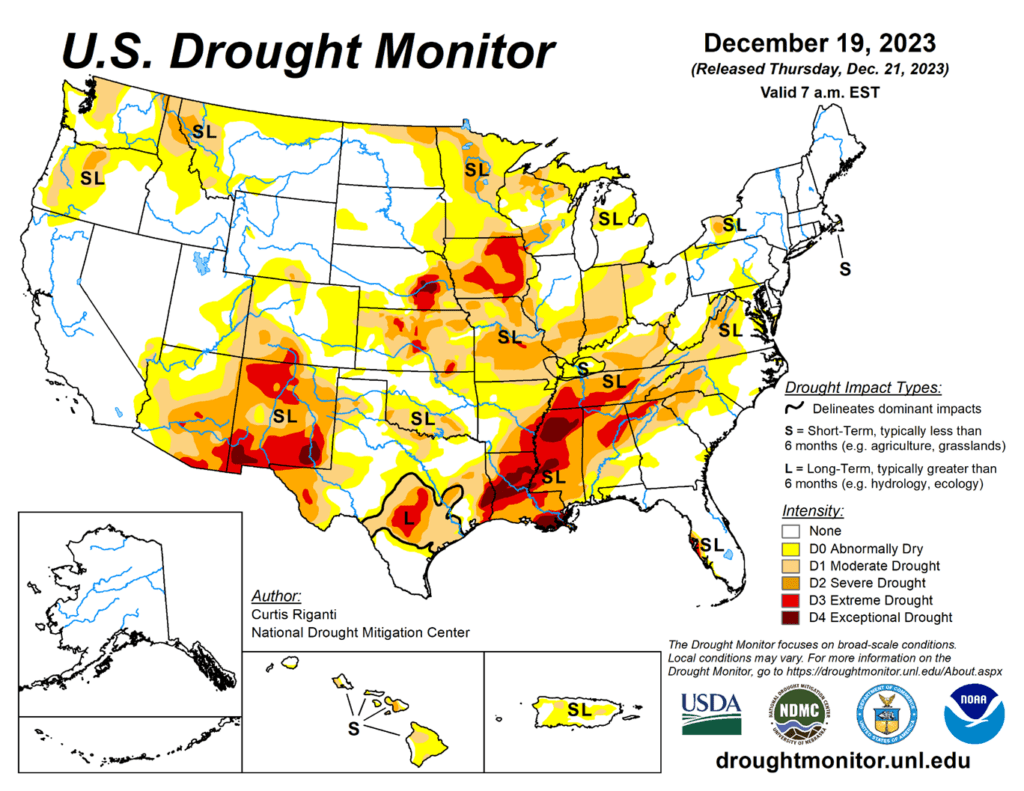
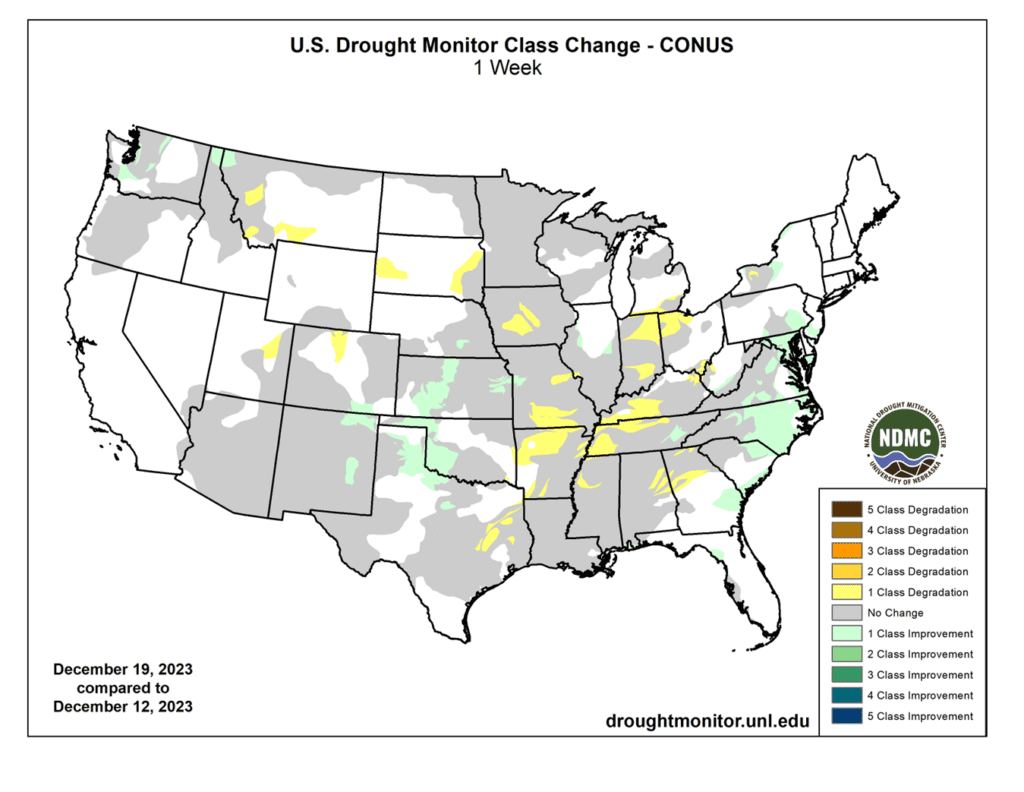

US 5 day precipitation forecast courtesy of NOAA, Weather Prediction Center.

Brazil 2 week forecast total precipitation courtesy of the National Weather Service, Climate Prediction Center.






